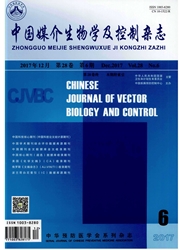

 中文摘要:
中文摘要:
目的分析云南省蚊虫分布特点及其与流行性乙型脑炎(乙脑)等虫媒病毒的关系,为防制提供依据。方法在云南省农村居民区住房、畜圈和野外竹林等生境捕蚊。结果采获成年雌蚊10属88种158909只,以库蚊、按蚊和伊蚊属蚊虫数量最多,分别占56.66%、25.35%和13.88%。在捕蚊总数中,居民区夜间捕获成蚊7属63种132081只,其中三带喙库蚊的构成比最高(42.12%);其次为中华按蚊(23.31%);野外白天捕获成蚊5属48种26828只,白纹伊蚊构成比最高(31.89%),其次为圆斑伊蚊(20.21%)。对8属29种3957批131538只雌性成蚊进行病毒分离,结果从5属17种蚊虫体内分离到乙脑病毒81株,以库蚊分离出的毒株最多(59株),占72.84%;其次为按蚊8株(9.88%)和伊蚊9株(占11.11%);曼蚊和阿蚊均为2株(各占2.47%)。分离到乙脑病毒最多的蚊种为三带喙库蚊(27株),占分离毒株总数的33.33%。结论居民区夜间活动蚊虫群落的优势种为三带喙库蚊、中华按蚊、棕头库蚊、霜背库蚊、伪杂鳞库蚊和迷走按蚊;野外白天活动蚊虫群落的优势种为白纹伊蚊、伪白纹伊蚊、圆斑伊蚊、骚扰阿蚊和刺扰伊蚊。三带喙库蚊和白纹伊蚊分别是云南省乙脑和登革热的丰要传播媒介。
 英文摘要:
英文摘要:
Objective To analyze the distribution characteristics of mosquito in Yunnan province and its relationship with the arborvirus such as Japanese encephalitis (JE), and provide the scientific basis for its prevention and control. Methods Mosquitoes were collected from the residential areas and the stables of livestocks in villages at night, and bamboo forests in the day. Results A total of 158 909 adult female mosquitoes were collected, which belonged to 88 species 10 Genera, and were mainly Culex, Anopheles and Aedes, accounting for 56.66%, 25.35% and 13.88% respectively. Among them, as many as 132 081 adult mosquitoes belonging to 63 species 7 Genera were caught in the residential areas at night, in which Cx.triaeniorhynchus has the highest proportion (42.12%), followed by An.sinensis (23.31%). And 26 828 adult mosquitoes belonging to 48 species 5 Genera were caught in the field by day, and the proportion of Ae.albopictu was highest (31.89%), followed by Ae.annandalei(20.21%). A total of 131 538 female mosquitoes that belonged to 29 species of 8 Genera were divided into 3957 groups. As a result, 81 strains of JE virus were isolated from mosquitoes (17 species 5 Genera). The virus strains isolated from Culex were the most (59 strains) accounting for 72.84%, followed by Anopheles (8 strains ) accounting for 9.88%, and Aedes (9 strains) accounting for 11.11%. Only two strains were isolated from Armigeres and Mansonia, accounting for 2.47%. About 27 strains JE were isolated from Cx.triaeniorhynchus, accounting for 33.33% of the total. Conclusion The dominant species in the residential areas are Cx.triaeniorhynehus, An. sinensis, Cx.fuscocephalus, Cx.whitmorei, Cx.pseudovishnui and An.vagus at night, while Ae.albopietu, s, Ae.pseudalbopict, Ae.annandalei, Ae.vexans and Ar.subalbatus were the dominant species in the field by daytime. Cx.triaeniorhynohus and Ae.albopictus are the main vectors of JE and Dengue fever in Yunnan province, respectively.
 同期刊论文项目
同期刊论文项目
 同项目期刊论文
同项目期刊论文
 期刊信息
期刊信息
